The Fjord City Strategy Leads the Way
The Fjord City is a result of deindustrialization and a renewed interest in the city
Oslo lost its shipbuilding industry in 1982, which marked the start of a radical transformation of the waterfront in the city center. The city was cut off from the fjord through the postwar development of a national transportation infrastructure, highways, railways, and freight and passenger terminals. Oslo wanted to reconquer its great connection to the beautiful surrounding fjord and island landscape. Large-scale and conflict-filled processes between the municipality and the government followed.
January 19th, 2000, the City Council of Oslo reached their ground-breaking resolution, choosing the Fjord City Strategy as the road ahead for the waterfront and the harbor areas, after an exciting election campaign during the fall of 1999 that earned the four parties supporting the Fjord City Strategy the majority.
Oslo City Wanted Improvement and Increased Capacity
The foundation for the resolution was the report “Fjordby eller Havneby?” [Fjord City or Harbor City?], a report commissioned by the City Council in 1996. The recommendations were that harbor terminals, highways and railway areas on the waterfront should be made more effective or relocated, and that the areas should be used for multifunctional urban development with residences, business, recreation and culture. Oslo was well into the period of population growth that is still the key factor for the urban development. Then, as now, there was a need to increase the city capacity and to improve the environmental situation. Oslo had a clear ambition to assert itself in the international competition. For the citizens, the mental map of the city was to be expanded, and the new areas that were opened, were to be seamlessly stitched together with the existing city and hold new opportunities and give everyone a better quality of life.
The Fjord City is being Carried Out as a Comprehensive Project with Several Components
After the resolution was reached, the Municipality of Oslo established an interdisciplinary research office – the Oslo Waterfront Planning Office – who started their work in 2002. The project gave the municipality an opportunity to make a focused and resourceful effort.
The Fjord City Office developed the Fjord City Plan, a comprehensive physical plan for the entire Oslo waterfront, where the capacity of the whole area was explored and concretized. A total of around two million square meters of new floorage was allocated for 9,000 new residences and 45,000 new workplaces. Space was reserved for several larger cultural institutions, like an opera house, a library, several museums and an aquarium, as well as dozens of hectares of park areas, public spaces and commons that connect the city to the fjord. The plan allocated about 10 km continuous waterfront promenade, a new tram line, several ports for local passenger boat traffic, bicycle facilities, and not to mention the highly effective multi-freight harbor terminal in Sydhavna, which offers a capacity of 400,000 TEU/year.
The City Council passed the Fjord City Plan in 2008, endorsing the guidelines for the detailed regulation and project implementation, research programs, ambitions for environmentally friendly urban development, and resolutions on predictability as a preparation for future development contracts. It was agreed to finance the new harbor terminal in Sydhavna in Oslo with the profit from Oslo Havn KF. The increased value accompanying the new regulation from harbor purposes towards city development purposes will finance a new local infrastructure for the urban development areas, such as streets, piers, squares, parks, surface water management, art in public urban spaces etc. All this is ensured by the advanced sales and development contracts between the Municipality of Oslo and the landowners.
Twelve years after the strategy was passed, 25% of the city development potential has been realized, providing about 500,000 m2 of new floorage. The citizens and the users of the city may now utilize this area. The implementation is continuously carried out, and more and more new buildings and facilities are utilized.
The Fjord City is Under Construction
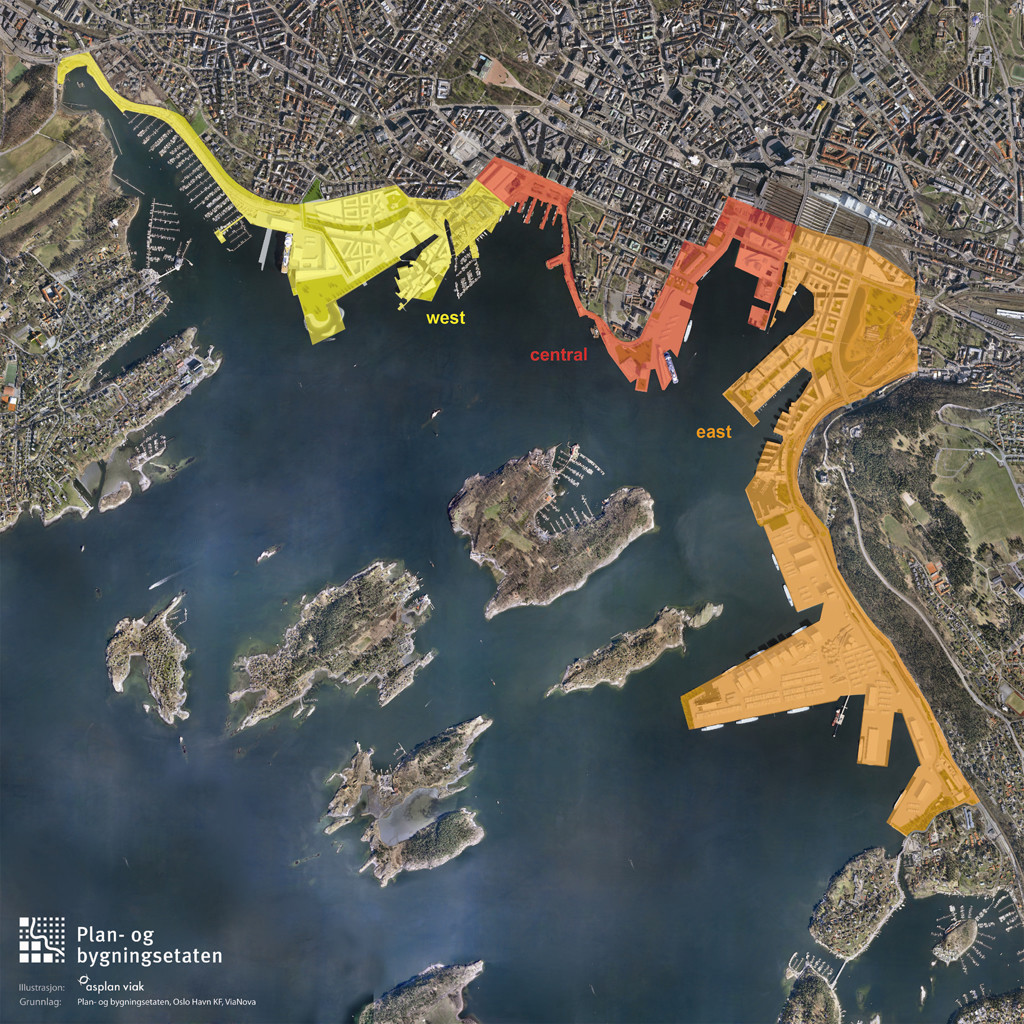 The Fjord City is divided into three main areas with eleven project areas. (© City of Oslo)
The Fjord City is divided into three main areas with eleven project areas. (© City of Oslo)
Eastern Section: Development of a New Infrastructure Opens Up for Implementation
The eastern section from Ormsund to Akerselva has up until now been characterized by a heavy development of infrastructure through the expansion and efficiency improvement of the multi-freight terminal in Sydhavna, where the first building stage is now in use, and through the building of the innovating immersed highway tunnel in Bjørvika, which opened for traffic in 2010. Both are crucial for the realization of the Fjord City: the freight terminal in order to move other freight terminals – such as Filipstad – away from the waterfront at the benefit of urban development; and the immersed tunnel because it is the key project in Bjørvika, allowing pollution and noise reduction and giving space for a new city structure.
Regarding the urban development, the Barcode Area and parts of Sørengutstikkeren are the completed building sites. The Medieval Park, with ruins from medieval Oslo, and the reconstructed waterfront from around 1350, is also a great success that hosts popular music festivals each year.
The Barcode buildings are based on a concept for the creation of 200,000 m2 of new floorage with 20% residences launched by the Dutch architect Winny Maas in 2002, with a building height of up to 67 meters. It resulted in public protest and a deferral in the political process. The slender high-rise buildings give the center of Oslo a new character of a growing Central Business District, where the diverse architecture contributes to changing the face of the city towards the fjord.
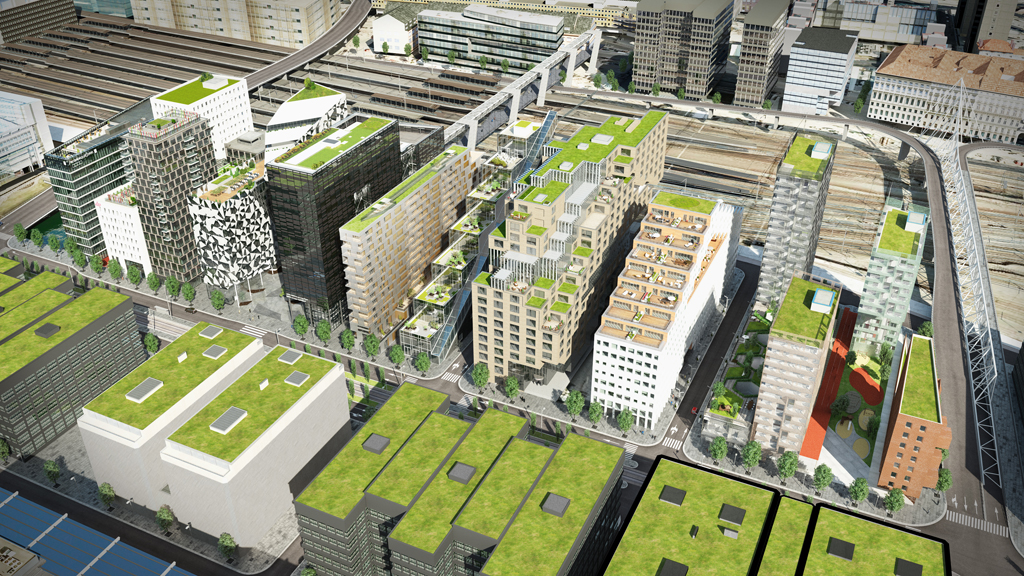 The Barcode Area consists of tall, slender lamellas. (© OSU AS)
The Barcode Area consists of tall, slender lamellas. (© OSU AS)
In the new resident zone Sørengutstikkeren, with about 100,000 m2 new floorage and 90% apartments, the first of around 2,000 residents have moved in, and the area will be completed in 2016. This development is distinguished by a strict architectonic moderation out of respect for the natural surroundings. A dark brick has been chosen as the common material for the eight blocks, which are built in the same height. This gives the buildings a calm and subdued impression from the Ekeberg protection area.
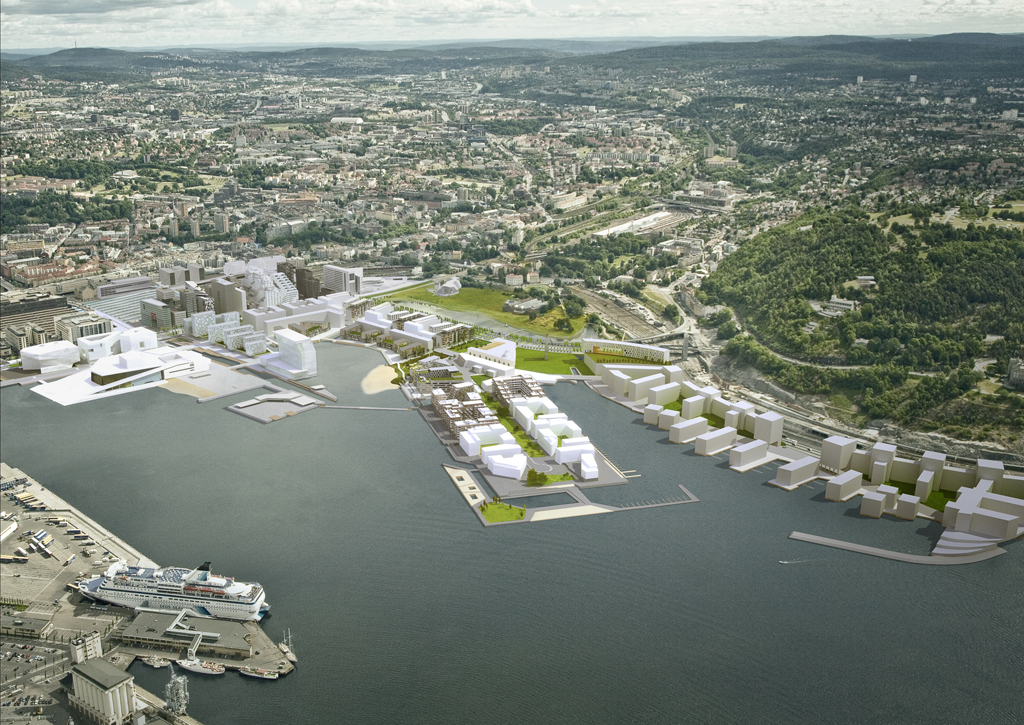 Sørenga Pier in the center of the image will become a popular residential area. The Opera House is to the left. (© ViaNova)
Sørenga Pier in the center of the image will become a popular residential area. The Opera House is to the left. (© ViaNova)
In 2008, an international architectural design competition was held for a new art museum for the Norwegian expressionist Edvard Munch. The Spanish architect Juan Herreros won with a bold, tall building that contrasted the low opera and ballet house. During spring 2013, a new political alliance in Oslo was formed, resulting in a City Parliament decision in favour of the winning Lambda project. The site was originally intended for an aquarium.
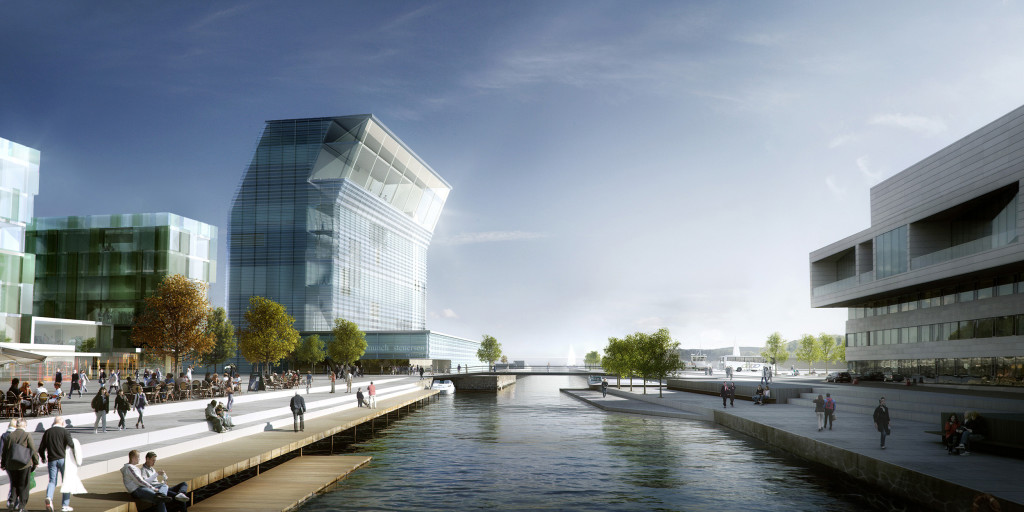 The Lambda Project for a new Munch Museum. (© MIR Visuals and Herreros Architects)
The Lambda Project for a new Munch Museum. (© MIR Visuals and Herreros Architects)
Western Section: Private Investments Provide Progress
In the western section, Aker Brygge is completed, and Tjuvholmen has progressed very well towards its completion in 2017. Both these privately owned areas are characterized by the fact that their urban development is not depended on new public transportation infrastructure.
As early as in 1992, the private shipyard Akers Mekaniske Verksted was transformed into Aker Brygge, with residences, offices, shopping, food and drink and culture. The area was among the first complete waterfront projects with all the urban functions included, and it is so popular that it functions as a landmark and a meeting place for the city. Now, the area is facing extensive modernization, which will fortify the area’s image as one of the most important finance and shopping neighborhoods in the city.
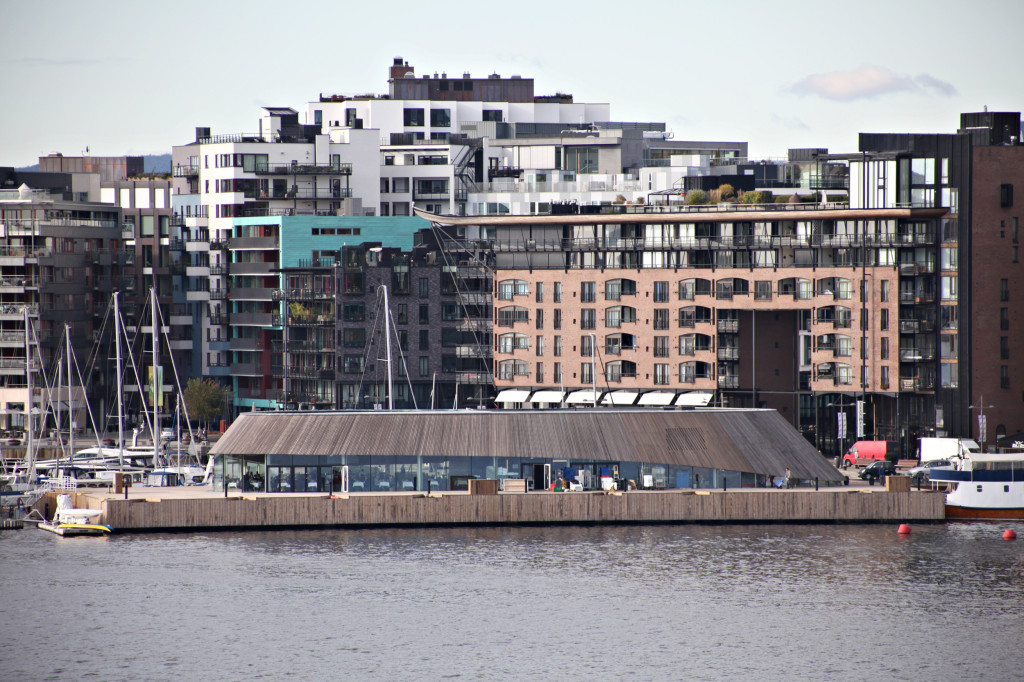 Aker Brygge with its new restaurant building, designed by Alliance Architects. (© City of Oslo)
Aker Brygge with its new restaurant building, designed by Alliance Architects. (© City of Oslo)
Tjuvholmen underwent a concept competition in 2002, where both the shaping of the area and the property price was the subject. The Municipality of Oslo sold the area to private investors, with an urban plan and a sales contract that regulate the shaping of the area and the accommodation for public use. In the fall of 2012, the private Astrup Fearnley Museum of Modern Art was opened in a building designed by the Italian architect Renzo Piano. Similarly to the new Opera House in Bjørvika, it is an architectural work that responds to the local conditions so successfully that the citizens of Oslo embrace it and use it with great pleasure. The architecture of Tjuvholmen is characterized by a greater diversity than that of Sørengutstikkeren.
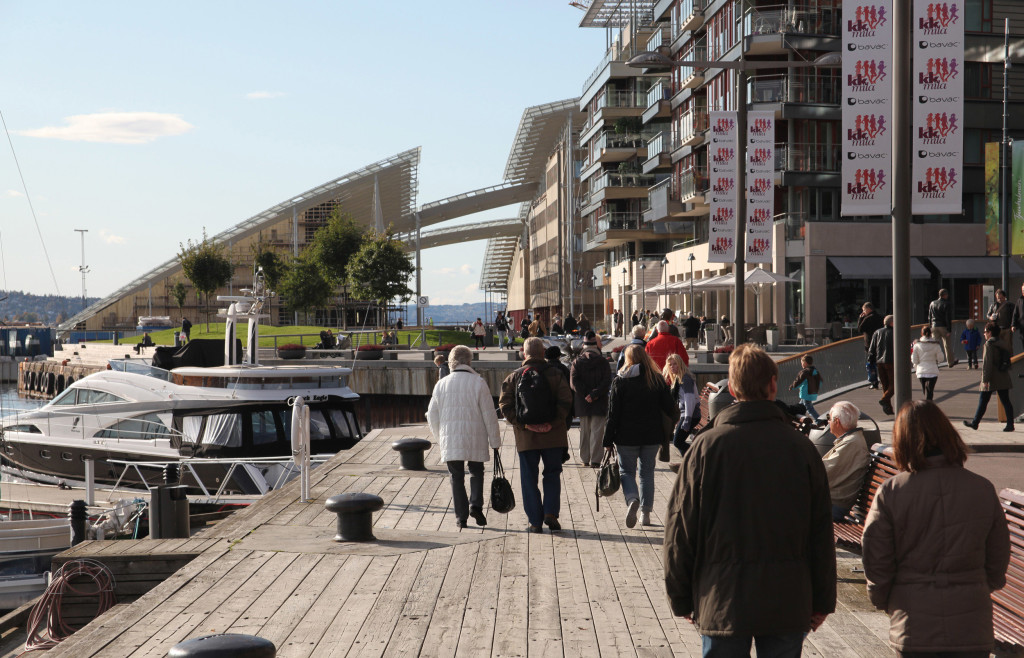 Tjuvholmen and the Astrup Fearnley Museum of Modern Art. (© City of Oslo)
Tjuvholmen and the Astrup Fearnley Museum of Modern Art. (© City of Oslo)
The Filipstad Area is the last of the large urban development areas of the Fjord City without an approved master plan. Around 450,000 m2 of new floorage, with 50% residences, 10 hectares of parks and urban spaces, a new highway tunnel, a school, development of a ferry and cruise terminal etc. is planned for. In the future, this will become one of the most attractive areas in Oslo.
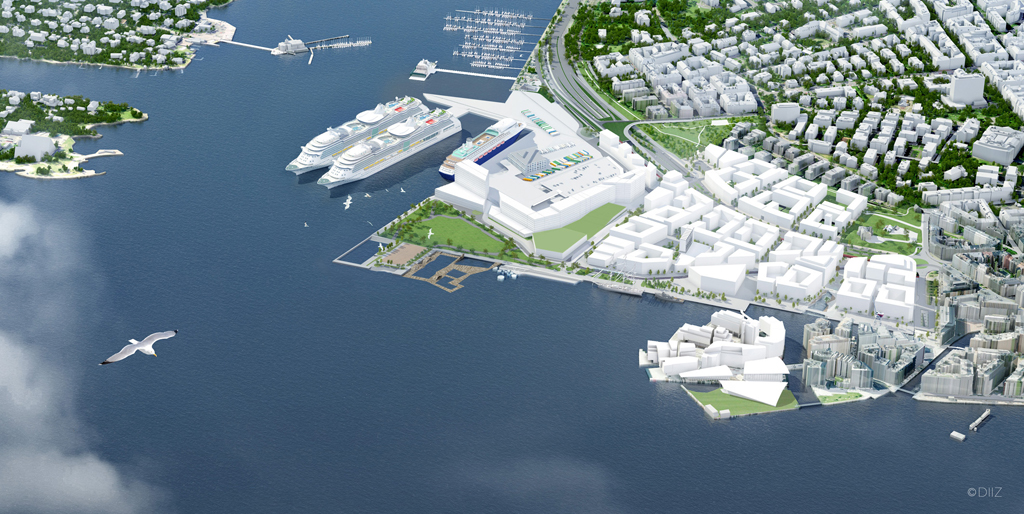 Master plan proposal for Filipstad. Tjuvholmen is in the bottom right corner. (© Diiz group for City of Oslo)
Master plan proposal for Filipstad. Tjuvholmen is in the bottom right corner. (© Diiz group for City of Oslo)
Central Section: Big Ongoing Debates
The new building for the Norwegian National Opera & Ballet was designed by the Norwegian architects’ office Snøhetta, who won the big international competition. The building was opened in 2008 and was instantly loved by the citizens, professionals and visitors alike. The building is a play on land and water; its low profile is adapted to the local landscape, and the stroke of genius to make the big roof landscape a directly accessible public space makes more than one million people visit the roof annually to enjoy the view of the city and fjord. The building is already listed as a cultural monument.
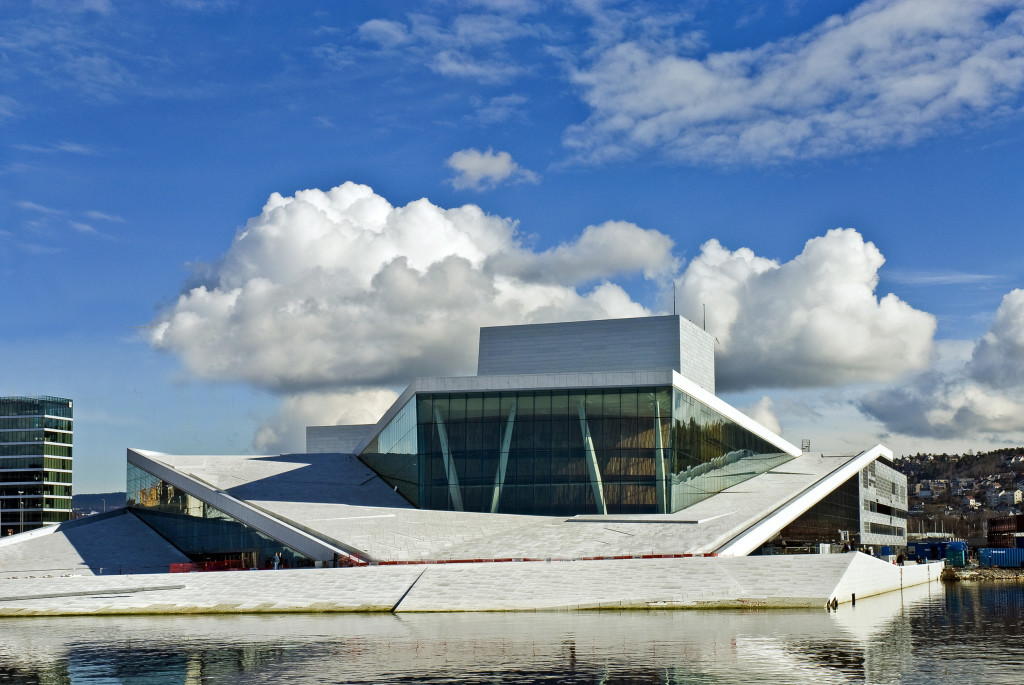 The Opera and Ballet House designed by architects Snøhetta. (© Jaro Hollan for the Norwegian Public Construction and Property Management)
The Opera and Ballet House designed by architects Snøhetta. (© Jaro Hollan for the Norwegian Public Construction and Property Management)
Between the Opera House and the largest public transportation hub in Norway, the new main city library will open in 2017 – yet another building designed by Norwegian architects: Lund – Hagem. The building design attends to the local conditions very successfully, and interplays with the varied lines and directions of the Opera House.
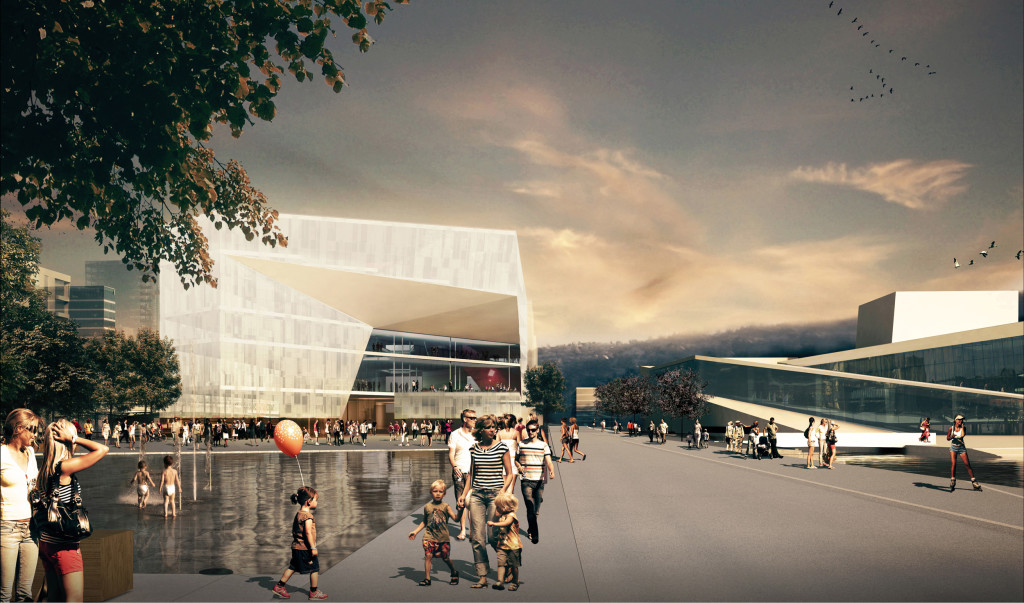 The Deichman Main Library will be built alongside the Opera House. (© Lund Hagem and Ateliér Oslo)
The Deichman Main Library will be built alongside the Opera House. (© Lund Hagem and Ateliér Oslo)
The vacated railway area of Vestbanen is under planning as the government is building a new national art museum based on the winning design by German Kleihues + Schuwerk Gesellschaft von Architekten mbHs there. The issue passed the Norwegian National Parliament june 2013, and the financing of 5,3 billion norwegian kroner (688 million €) is granted.
An ongoing debate addresses what public attraction may be worthy of being built on the most protruding headland of Vippetangen. It will be one of the most exposed buildings on the waterfront of Oslo and contribute to the future identity of the capital. Realizing the urban development potential is demanding because of the proximity to the Akershus Fortress, one of the most important cultural monuments in Norway, and because it has been decided to still have an international ferry and cruise terminal there.
Work is in progress for the development of the continuous waterfront promenade.
Summary
The Fjord City strategy has led to several positive outcomes for Oslo, first of all that the city has many new opportunities to offer for urban recreation and closeness to nature. The interplay between city centre and fjord has been strengthened. In addition, it seems that the international focus on Oslo has increased, the city has now appeared on international rankings over attractive cities, first of all due to the successful Opera House, but as well the interest in our urban development strategies and instruments for realization. The rearrangement of some cultural institutions has benefitted from new location possibilities, giving rise to important public discussions. At last but not least; a radical remake of the motorway system has been accomplished, enhancing Oslo’s physical environment.
In the future, attention has to be continued and focus on the subjects of environmentally friendly development, and the recreational possibilities opened by the water itself. The ongoing work with the Harbour Promenade will give access to these issues, as well give the city a positive entrance to more active and direct communication with the local inhabitants and users.
As we do not want to end up with a generic waterfront which could be placed in any city, it is crucial for us to take good care of the specific and unique qualities of Oslo’s waterfront.